
About Andrew Cusack
 Writer, web designer, etc.; born in New York; educated in Argentina, Scotland, and South Africa; now based in London.
Writer, web designer, etc.; born in New York; educated in Argentina, Scotland, and South Africa; now based in London. read more
News
Blogs
Reviews & Periodicals
Arts & Design
World
France
Mitteleuropa
Knickerbockers
Argentina
The Levant
Africa
Cape of Good Hope
Netherlands
Scandinavia
Québec
India
Muscovy
Germany
Academica
New York in the Early Republic
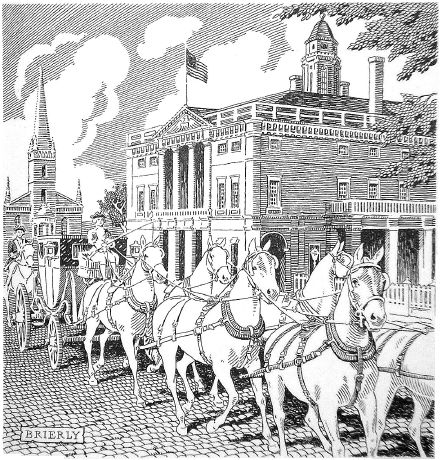
IT IS NOT OFTEN remembered that New York was the first capital of the United States and, as such, was home to the executive, legislative, and judicial branches of the new republic, albeit only for a short time. Federal Hall (above, with the Presidential carriage) was originally constructed in 1699 as a City Hall for New York. It was in this building at 26 Wall Street in 1735 that John Peter Zenger was tried and acquitted of libeling the Governor, affirming the Freedom of the Press. The Continental Congress began meeting in the City Hall in the 1780’s, and with the ratification of the new Constitution of the United States it became the first home of the federal government. Having been elected the first President of the United States, General George Washington was inaugurated on the balcony of the building on April 30, 1789.
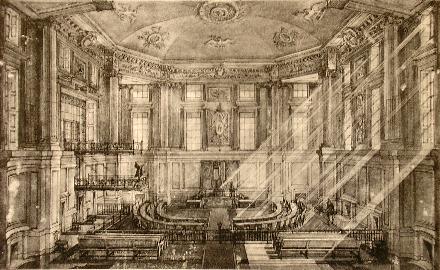
The structure needed to be renovated to meet the needs of the new government, and Pierre Charles L’Enfant was engaged to redesign the structure accordingly. The new Federal Hall featured dignified chambers to house the Congress. The House of Representatives Chamber (above and close-up below) was a stately rectangular room, despite which the Congressmens’ seating was arranged in a semicircular pattern.
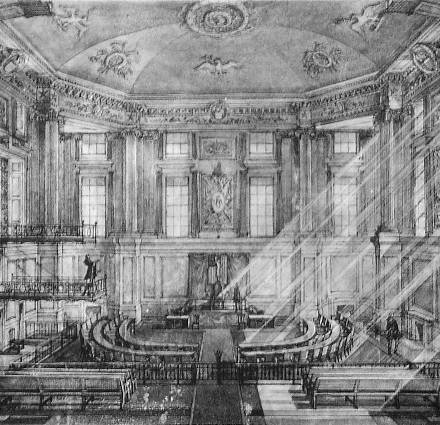
The Speaker’s Chair was on a raised dais, backed by the American flag, above which further were the monogrammed initials of the United States of America. The bountiful sunlight filtering through the many windows would warm the room and, failing that, there were also six fireplaces. The public could view sittings in the chamber from seating located on the House floor, seperated from the Representatives by a balustrade, as well as from two galleries suspended from the chamber’s wall to the Speaker’s right.
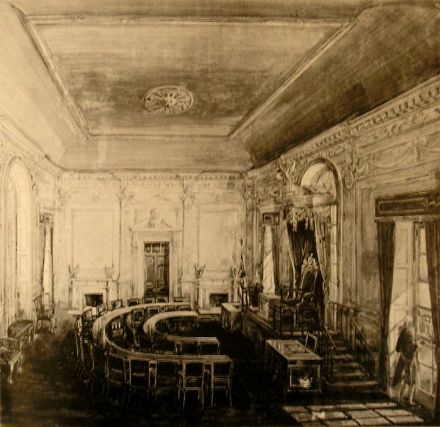
The Senate, meanwhile, met in a smaller chamber but even more stately in design. Again, the members’ desks were arranged in a semicircular pattern while the President of the Senate (a position the Vice-President is designated by the Constitution) was given a positively lordly throne-like chair on a dais from which to preside over the proceedings.
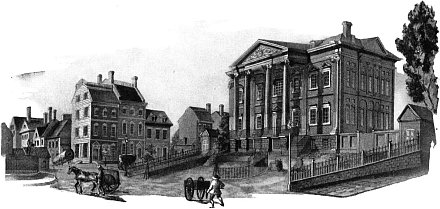
In 1790, Government House was constructed on Bowling Green by the State of New York to serve as the Presidential residence in hopes that the federal government might be persuaded to retain New York as the capital of the United States. The same year, however, saw the passage by Congress of the Residence Act which called for a new capital to be built on the banks of the Potomac near Georgetown. (It is ironic that the permanent capital of the new republic named after our first president, Washington, would be built so approximate to a town named after our next to last king, George II). The Act also called for the federal government to move further south to Philadelphia until suitable buildings in the new federal city on the Potomac could be devised and executed. Despite all this, Government House was brought to completion two years later in 1792.
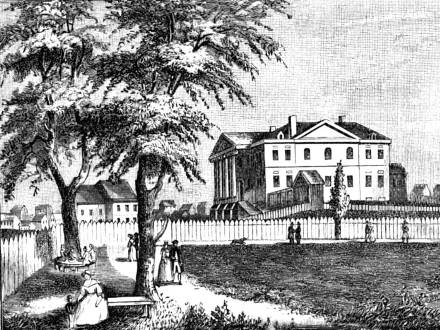
“Government House,” writes historian William Seale, “could hardly have been more British in its design. The tall building of red brick [later painted white] was set up on a rusticated stone basement and was rich in Anglo-Palladian ornament, not unlike that which would appear later on the White House.” It was described by John Drayton, a South Carolinian visitor to New York in 1793 as “plac’d upon a handsome elevation, and fronting roadway, having before it an elegant elliptical approach, round an area of near an acre of ground, enclosed by an iron railing. … [It] is two stories high. Projecting before it is a portico covered by a pediment; upon which is superbly carved in basso relievo, the arms of the State, supported by justice and liberty, as large as life. The arms and figures are white, placed in a blue field; and the pediment is supported by four white pillars of the Ionic order, which are the height of both stories.”
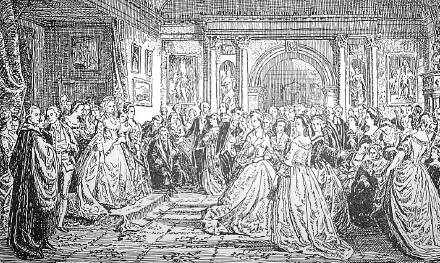
The First Lady, Martha Washington, presides over a reception in the Presidential residence, New York, 1789.
With the removal of the federal government, Government House became the residence of the Governors of our great state, and as such was home to such great men as John Jay and ‘Magnus Apollo’ himself, DeWitt Clinton. After the government of the State repaired to Albany in 1797, the building was used as a Custom House, then home to the collections of the New-York Historical Society, and then rented out as the Elysian Boarding and Lodging House (perhaps somewhat coincidental, as the current residence of the President of the French Republic is the Elysée palace). The structure suffered under these varying uses, and was sold to the City in 1813 and finally torn down in 1815.
Meanwhile, Federal Hall returned to the City of New York and the lack of a suitable meeting place for the State Assembly may have contributed to the decision to move the seat of government up the Hudson River to Albany. Poorly maintained, Federal Hall was home to the City government until 1812 when the current City Hall was completed. The Mayor, City Council and assorted municipal functionaries moved into the new City Hall while Federal Hall was sold off and demolished. In 1842, the United States Customs House was built on the same site, later serving as a Sub-Treasury and then Federal Reserve Bank. This building survives and continues today as the Federal Hall National Monument, owned and operated by the National Parks Service. How sad that these important structures in the history of the Empire State and the early history of the United States have not been preserved for posterity.
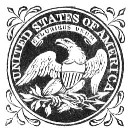
Search
Instagram: @andcusack
Click here for my Instagram photos.Most Recent Posts
- Katalin Bánffy-Jelen, R.I.P. March 3, 2025
- Substack Cusackiensis March 3, 2025
- In the Courts of the Lord February 13, 2025
- American Exuberant February 10, 2025
- Crux Alba Journal Launch February 10, 2025
Most Recent Comments
Book Wishlist
Monthly Archives
Categories



Very interesting set of pictures . They meet my current interest in L’Enfant’s architectural activities in New York. May I know where are the original engravings?
Great blog, thanks.
A singular set of events took place in 1790, when New York became the first site that a US treaty was negotiated with an indigenous nation outside of “Indian country.” A delegation of 28 “upper, middle, lower and Seminole” Muscogee (Creek) leaders arrived in New York and set into negotiations with the Secretary of War.
The final Treaty of 1790 was the last action taken by the Senate in Federal Hall before their adjournment to Washington, D.C.
Upon notice of a masonic ceremony to “close” the building, the Muscogee responded and followed the Masons with a ceremony of their own. That site is the approximate location of the current New York Stock Exchange.
Upon return to their lands, the Muscogee leaders shared their impressions of New York City, hoping they would one day have a city like that. In Council, some leaders pointed out that there were two towns of the confederacy named Tvkpafkv (tuk-PAWF-kuh), which sometimes caused confusion. Leaders from Vkfuske (uhk-FUS-kee), as the mother town of one Tvpafkv town, gave consent to the renaming of their daughter town, which then took the name Nooyakv (noo-YAW-kuh), sometimes shown on maps of Muscogee lands as “New Yorker Town.” Following removal to Indian Territory, the Vkfuske and Nooyakv settled in various locations, finally neighboring each other (after the US Civil War) south of the Deep Fork River in current Okfuskee County, Oklahoma. The old boarding school building still stands there, preserved as Nuyaka Mission.